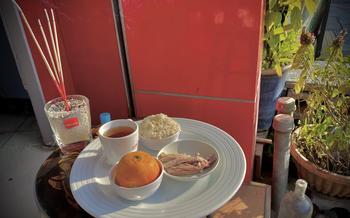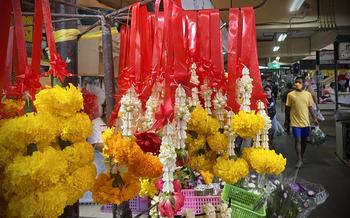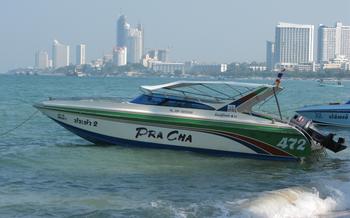
Wat Suwan Kuha (Buddha Cave Temple)
- A Temple in a Cave
- Exploring the Cave's Interior
- Marveling at the Buddha Images
- Experiencing Spiritual Serenity
- Offering Prayers and Making Merit
- Exploring the Temple Grounds
- Interacting with the Local Community
- Respecting Cultural and Religious Customs
- Capturing Memorable Moments
- Planning Your Visit
- Solo Travel and Group Tours
- Accessibility and Special Needs
- Insider Tip: Hidden Gem Nearby
A Temple in a Cave
In the heart of Phang Nga, Thailand, nestled within a limestone karst, lies Wat Suwan Kuha, a Buddhist temple that is as unique as it is awe-inspiring. Also known as the Buddha Cave Temple, it is an architectural marvel that seamlessly blends natural beauty with religious significance.
The history of Wat Suwan Kuha dates back centuries, with legends attributing its discovery to a wandering monk who was led to the cave by a tiger. Over time, the cave became a place of worship for local communities, and in the early 20th century, it was transformed into a temple with the construction of Buddha images and murals.
The cave itself is a sight to behold, with its towering stalactites and stalagmites creating a cathedral-like atmosphere. As visitors enter the cave, they are greeted by a series of chambers and tunnels, each adorned with sacred Buddha images and vibrant murals. The temple's most revered image is a large reclining Buddha, known as the "Sleeping Buddha," which exudes an aura of peace and serenity.
Wat Suwan Kuha holds immense cultural and religious significance for local communities. It is a place where devotees come to pray, make merit, and seek spiritual guidance. During festivals and special occasions, the temple bustles with activity as people gather to celebrate and honor their beliefs.
Exploring the Cave's Interior
Stepping through the unassuming entrance of Wat Suwan Kuha, you are met with an awe-inspiring sight: a vast and majestic cave, transformed into a sacred temple. The natural beauty of the cave is captivating, with intricate stalactites and stalagmites adorning the walls and ceiling, creating an ethereal and otherworldly atmosphere.
The cave's interior is divided into several chambers and tunnels, each with its own unique features and significance. As you make your way through the labyrinthine passages, you'll encounter a series of stunning Buddha images, murals, and sacred altars, each telling a story of devotion and faith.
One of the most striking features of the cave is the main chamber, where a towering golden Buddha statue stands majestically, radiating an aura of serenity and peace. The chamber's walls are adorned with intricate murals depicting scenes from Buddhist mythology and history, adding to the sacred ambience of the space.
In the deeper recesses of the cave, you'll find meditation chambers and prayer halls, where devotees come to seek spiritual solace and enlightenment. The tranquil atmosphere of these secluded spaces invites contemplation and reflection, allowing visitors to connect with their inner selves and find moments of spiritual connection.
Exploring the cave's hidden corners is an adventure in itself. With a flashlight in hand, you can venture into narrow passages and discover hidden chambers adorned with delicate stalactites and stalagmites. The cave's intricate network of tunnels and chambers is a testament to the power of nature and the ingenuity of the ancient craftsmen who transformed this natural wonder into a sacred sanctuary.
Marveling at the Buddha Images
Within the cave's depths, visitors are greeted by an awe-inspiring collection of Buddha images, ranging from small, serene statues to towering, majestic figures. These sacred representations of the Buddha embody the essence of compassion, wisdom, and enlightenment.
Each Buddha image is meticulously crafted, showcasing the intricate details and symbolism that characterize Thai Buddhist art. The postures, mudras (hand gestures), and facial expressions of the Buddhas convey profound meanings and teachings. From the serene countenance of the seated Buddha to the dynamic energy of the standing Buddha, each statue tells a unique story.
Among the most revered Buddha images in the cave is a colossal reclining Buddha, stretching over 15 meters in length. This magnificent statue exudes an aura of tranquility and peace, inviting visitors to contemplate the nature of impermanence and the cycle of rebirth.
As you wander through the cave, you'll encounter a diverse array of Buddha images, each with its own distinctive features and significance. Some Buddhas are adorned with intricate gold leaf, while others are carved from rare and precious materials. Some depict the Buddha in meditative repose, while others portray him engaged in teaching or performing miracles.
These Buddha images are not mere works of art; they are objects of deep devotion and veneration for the local community. Visitors are encouraged to pay their respects and offer prayers to the Buddha, following the traditional customs and etiquette of Thai Buddhist temples.
By immersing yourself in the presence of these sacred images, you'll gain a deeper understanding of the profound spirituality and rich cultural heritage that define Wat Suwan Kuha and the surrounding region.
Experiencing Spiritual Serenity
Wat Suwan Kuha offers a serene and tranquil atmosphere that invites visitors to connect with their spiritual side. The natural surroundings, the gentle sound of dripping water, and the dim candlelight create a calming effect that encourages meditation and reflection.
Visitors can find quiet corners within the cave to sit in silence and practice mindfulness. The flickering candlelight casts a warm glow on the Buddha images, creating a sense of peace and tranquility. The sound of water dripping from the stalactites adds to the ambiance, reminding visitors of the impermanence of all things.
Many visitors find that the cave temple is an ideal place to escape the hustle and bustle of everyday life and reconnect with their inner selves. Whether sitting in meditation, offering prayers, or simply taking in the beauty of the surroundings, Wat Suwan Kuha provides a unique opportunity for spiritual growth and self-reflection.
Offering Prayers and Making Merit
In Thai Buddhist culture, making merit, or performing good deeds, holds immense significance. At Wat Suwan Kuha, visitors have the opportunity to engage in various merit-making activities that bring good fortune, blessings, and spiritual growth.
One way to make merit is by lighting candles within the temple's sacred chambers. The flickering candlelight creates a serene and meditative atmosphere, symbolizing the dispelling of darkness and negativity. Visitors can also offer flowers to the Buddha images, a gesture of devotion and respect.
Another common practice is to donate to the temple. Donations can be made in the form of money, food, or other supplies. These contributions help maintain the temple grounds, support the resident monks, and ensure the continuation of Buddhist teachings and practices.
By participating in merit-making activities, visitors not only contribute to the preservation of Wat Suwan Kuha but also cultivate their own spiritual development. It is a meaningful way to connect with the local culture and traditions, and to experience the essence of Thai Buddhism firsthand.
Exploring the Temple Grounds
Beyond the awe-inspiring cave temple, Wat Suwan Kuha boasts beautifully landscaped grounds that invite visitors to explore and soak in the serene atmosphere. As you step out of the cave, you'll find yourself in a tranquil garden adorned with lush greenery and colorful flowers. Pathways meander through the garden, leading you to hidden corners and secluded spots where you can find solace and tranquility.
In the heart of the temple grounds stands a majestic bell tower, its intricate design and towering height symbolizing the sacredness of the site. The gentle clanging of the bell fills the air with a melodious sound, adding to the spiritual ambiance.
A serene pond glimmers in the sunlight, reflecting the surrounding greenery and the golden stupas that dot the landscape. Visitors can sit by the pond's edge, listening to the soothing sounds of water and immersing themselves in the peaceful surroundings.
Meditation pavilions, nestled amidst the tranquil gardens, offer visitors a dedicated space for reflection and spiritual practice. These pavilions provide a serene environment where one can escape the hustle and bustle of daily life and connect with their inner selves.
The temple grounds are also home to the living quarters of the monks who reside at Wat Suwan Kuha. These humble dwellings, often constructed from natural materials, offer a glimpse into the simple and dedicated lives of the monks. Visitors are welcome to interact with the monks respectfully, learning about their daily routines and seeking their blessings.
Throughout the temple grounds, visitors will encounter various statues, stupas, and other religious artifacts that add to the sacredness of the site. Each artifact holds a unique story and significance, inviting visitors to delve deeper into the history and beliefs of Thai Buddhism.
Interacting with the Local Community
Visiting Wat Suwan Kuha presents an excellent opportunity to engage with the warm and welcoming local community. Embrace the chance to learn about their culture and way of life by striking up conversations with the friendly locals. Support their livelihoods by purchasing unique souvenirs from the temple shop, where you'll find a variety of handcrafted items that make for cherished mementos of your visit. Savor the delectable local cuisine by dining at nearby restaurants, where you can sample authentic Thai dishes prepared with fresh ingredients. Through these interactions, you'll gain insights into the vibrant culture and hospitality that define the region. Remember to communicate respectfully and observe cultural norms, such as the wai, the traditional Thai greeting, to show your appreciation for the local customs.
Respecting Cultural and Religious Customs
When visiting a sacred site like Wat Suwan Kuha, it is essential to be mindful of the cultural and religious customs of the local community. As a visitor, it is your responsibility to show respect and maintain the sanctity of the temple grounds.
Before entering the temple, remove your shoes and leave them in the designated area. This is a sign of respect and helps to keep the temple clean. Dress appropriately by covering your shoulders and knees. Avoid wearing revealing or beachwear.
Once inside the temple, maintain a quiet and reverent demeanor. Refrain from talking loudly or engaging in disruptive behavior. Remember that the temple is a place of worship for many people, and your actions should not disturb their spiritual practices.
If you wish to take photos, be respectful and avoid using flash photography. Ask permission before taking photos of people, especially monks. It is also important to be mindful of the sacred nature of the Buddha images and avoid touching or posing with them in a disrespectful manner.
By observing these cultural and religious customs, you can show your respect for the local community and contribute to preserving the sanctity of Wat Suwan Kuha for future generations.
Capturing Memorable Moments
Visiting Wat Suwan Kuha presents a fantastic opportunity to capture the beauty and serenity of this sacred site through photography. The cave's unique formations, intricate murals, and awe-inspiring Buddha images offer a wealth of subjects for photography enthusiasts.
To make the most of your photographic experience, come prepared with the right equipment. A wide-angle lens is essential for capturing the vastness of the cave's interior, while a tripod will help you stabilize your shots and avoid camera shake.
As you explore the cave, keep an eye out for interesting compositions and lighting. The natural light filtering through the cave's openings can create dramatic effects, so experiment with different angles and perspectives to capture the best shots.
Be respectful of the sacred nature of the site and avoid disturbing others while taking photos. Silence your camera's shutter sound and be mindful of your movements to minimize disruption to the peaceful atmosphere.
Don't forget to share your stunning photos with the world! Use social media platforms like Instagram to showcase your best shots and inspire others to visit this hidden gem. Remember to tag your photos with #WatSuwanKuha and #PhangNga to connect with other travelers and share your experiences.
Planning Your Visit
Planning a visit to Wat Suwan Kuha requires careful consideration to ensure a smooth and enjoyable experience. The temple's opening hours are generally from 8 am to 5 pm daily, allowing ample time for exploration. Entrance to the temple is free of charge, welcoming visitors from all backgrounds to experience its sacred beauty.
To make the most of your visit, consider the best time of year to travel. The dry season, from November to April, offers pleasant weather conditions, with minimal rainfall and clear skies, making it ideal for exploring the cave's intricate details. During the rainy season, from May to October, the cave takes on a different charm, with lush greenery and the sound of dripping water adding to the mystical atmosphere.
While visiting Wat Suwan Kuha, take the opportunity to explore other attractions in the Phang Nga region. The nearby Phang Nga Bay is a must-see, with its stunning limestone karsts rising from the emerald waters. A boat tour of the bay offers breathtaking views and an unforgettable experience.
To create a personalized itinerary, consider your interests and time constraints. If you have limited time, focus on exploring the cave temple and its immediate surroundings. For a more in-depth experience, allocate a full day or more to visit other attractions in the region, such as the Phang Nga Bay, the Elephant Sanctuary, or the Tsunami Memorial Park.
Solo Travel and Group Tours
Whether you're a lone wanderer seeking spiritual solace or part of a group eager to delve into Thailand's rich culture, Wat Suwan Kuha offers a fulfilling experience for all. Solo travelers can immerse themselves in the serene atmosphere of the cave temple at their own pace, taking time to meditate, explore the hidden corners, and connect with the spiritual energy of the site.
For those who prefer the camaraderie of a group, guided tours provide an enriching experience. Knowledgeable guides share insights into the history, legends, and religious significance of the temple, bringing the cave's stories to life. Group tours also offer opportunities to interact with fellow travelers from diverse backgrounds, fostering a sense of community and shared exploration.
To ensure a safe and enjoyable experience, it's advisable to book a tour with a reputable operator. Look for companies that prioritize responsible tourism practices, support local communities, and maintain high standards of safety and customer service. Whether you choose to journey solo or as part of a group, Wat Suwan Kuha promises an unforgettable experience that will leave a lasting impression on your soul.
Accessibility and Special Needs
Wat Suwan Kuha welcomes visitors with disabilities and special needs and strives to ensure an inclusive and accessible experience for all. The temple grounds are well-maintained, with ramps and designated parking areas to facilitate easy access. For those with limited mobility, wheelchairs are available upon request. The temple staff is friendly and accommodating, providing assistance wherever needed. Visitors with hearing or visual impairments can request sign language interpretation or descriptive tours to enhance their visit. By embracing accessibility, Wat Suwan Kuha creates a welcoming environment where everyone can explore and appreciate the beauty and tranquility of this sacred site.
Insider Tip: Hidden Gem Nearby
While exploring Phang Nga, don't miss the opportunity to uncover a hidden gem just a short distance from Wat Suwan Kuha. Nestled amidst lush greenery and tranquil surroundings, the Sai Rung Waterfall awaits discovery. This picturesque waterfall cascades down multiple tiers, creating a mesmerizing spectacle of nature's beauty. Take a refreshing dip in the cool waters, soak in the serenity of the surroundings, and capture stunning photographs of this hidden paradise. To reach Sai Rung Waterfall, follow the road signs from Wat Suwan Kuha and embark on a short hike through the scenic countryside. The path is well-maintained and suitable for all fitness levels, making it an accessible adventure for everyone. Embrace the opportunity to explore beyond the main tourist attractions and immerse yourself in the hidden wonders of Phang Nga.






